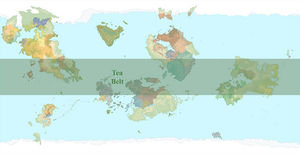Tea belt

The tea belt refers to the tropical and subtropical climates that camellia sinensis (tea) is most commonly grown in. Some varieties can tolerate oceanic climates, but these are not often counted in the traditional sense of the tea belt as they are hybridized cultivars that are excluded from the Royal Burgoignesc Tea Processing Society's classification of true teas (Burg: tes vertadiers).
Likely high output tea growing regions

Every five years, the Royal Burgoignesc Tea Processing Society conducts a global survey of existing tea plantations, land under development as tea plantation, and currently unexploited land that can be used for tea processing, called the Burgoignesc Guide to Tea Processing: A compendium of soil, climate, wind, and altitudinal considerations for the growing of camellia sinensis and nothing else, because camellia taliensis is not tea.
- Tierro-Ormatian border highlands
- Southcentral Tierradorian highlands
- Paulastran central highlands
- Southern half of the eastern Carnland highlands
- Yonderro-Anglei border highlands
- All highlands in Urcea
- Sacatian northcentral highlands
- Kagazo-Jazee border highlands
- Southwestern Jazee highlands
- Jazo-Thervalan border highlands
- All highlands in Thervala
- All highlands in Kandara
- Southern coastal highlands in Zaclaria
- Kandaro-Ankivara border highlands
- Canpei-Rusana-Daxia border highlands
- All highlands in Daxia
- All highlands in The Holding
- Northern Pukhtunistan highlands
- Northern third of the east-central Umardwal highlands
- All elevations in Battganuur
- Caphiro-Xelphia border highlands
- All highlands in Caphiria
- All highlands in Cartadania
- Northern highlands in Puertego
- Pescanice tea region (Equatorial Ostiecia)
- All highlands in Castadilla (and Almadaria)